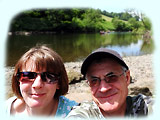London - Britain at War & Churchill War Rooms,
September 2012
On our first trip to wonderful London since 2008 we
decided to take in some Second World War (WWII) attractions.
First up was the Britain at War Experience in Tooley Street, a short
walk from London Bridge mainline station. Next we visited
Churchill War Rooms at Westminster, the captivating underground bunker
for the wartime government cabinet. Then we took a stroll in the
early autumn sunshine through St. James's Park, seeing Buckingham
Palace on the way, to the recently unveiled Bomber Command Memorial in
Green Park.
Please note that the Britain at War Experience has
closed since our visit.
|
|
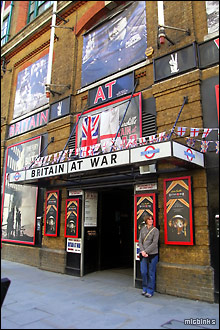
After a 10 minute walk from London Bridge station down the (very) busy
Tooley Street we arrived at our first attraction, the Britain at War
Experience. It didn't look much from the outside...
|
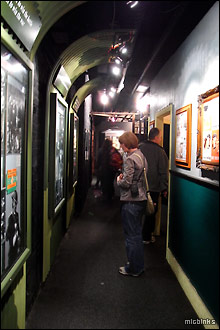
...but once inside Britain at War our first experience was via a 'lift'
down to an area decked out as a London Underground air raid shelter, a
place many Londoners headed for during air raids.
|
|
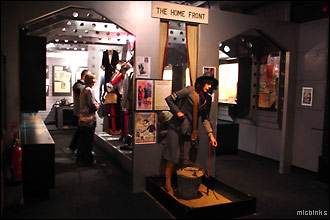
There was an underground wartime cinema here too, showing the wartime
news, followed by the Home Front section which gave an insight into how
the war affected everyday lives. So with the menfolk called up
into the services...
|
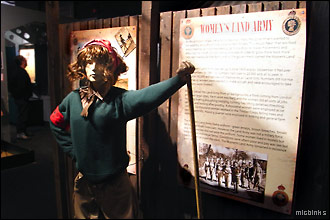
...the Women's Land Army took over many farming jobs to keep Britain in
food during WWII. They were paid £1 12 shillings (£1.60) for a 50
hr week while Britain was at war. We also saw a bomb disposal
display, ration books and WWII shops.
|
|
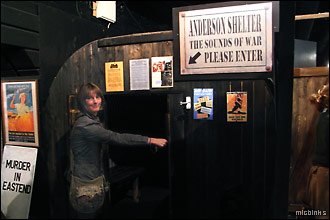
Belinda just couldn't resist trying out this Anderson shelter at the
Britain at War Experience. Inside, just as it says on the tin, we
could hear the bombs dropping and explosions all around during an air
raid, well scary! It provided a glimpse of what our grandparents
endured during the Blitz in WWII.
|
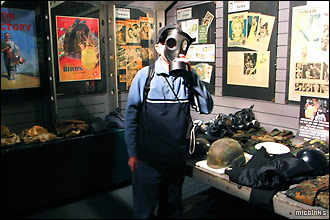
Mike just couldn't resist trying out this wartime gas mask - just don't
go trying out all that other clobber too! Some 44 million gas
masks were issued to civilians prior to the Second World War and had to
be carried at all times in case the Germans dropped poison gas, but
they never did.
|
|
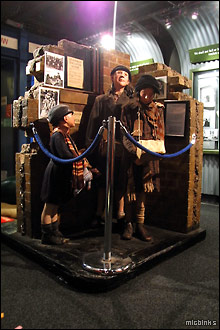
Many children from towns and cities were evacuated to the countryside
during World War Two and stayed with host families. Many
returned, older, years later and their families hardly recognised them;
others had inevitably lost one or even both parents.
|
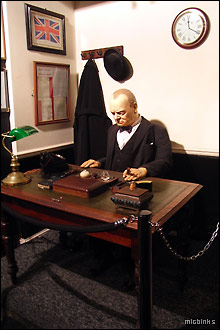
So here's the great man himself busy at his desk in Britain at
War. Winston Churchill was Britain's Prime Minister throughout
the war, later to became Sir Winston Churchill in recognition of
leading Britain to victory in the Second World War.
|
|
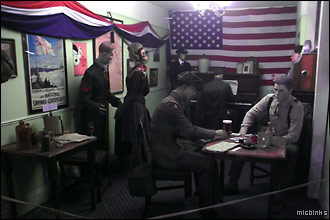
We learnt that beer (and cigarettes) were not rationed during the war
as they were considered morale boosters. In this smoky pub scene
(called Rainbow Corner, a GI club) we saw off-duty servicemen enjoying
a pint or three, while the GI guy on the left appeared to be chatting
up a pretty girl (Land Girl maybe?). Many Americans came over to
help Britain's war effort and their cheeky persona led to the famous
expression: over-paid, over-sexed and over here! Jitterbug anyone?
|
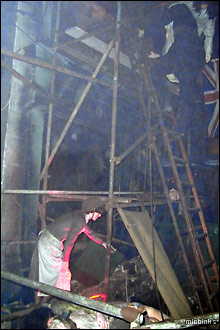
This last area at the Britain at War Experience depicted the utter
devastation caused in the Blitz by a German air raid, complete with
shuddering sound effects, smoke and dramatic lighting.
|
|
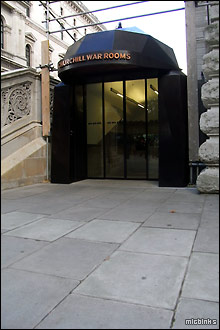
A short tube trip later and we arrived at the rather nondescript
entrance to Churchill War Rooms, the secret underground headquarters of
the wartime British government. We were issued with...
|
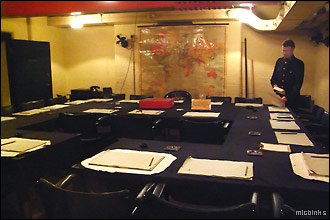
...an Audio Guide handset for the self-paced tour. Churchill War
Rooms is part of the Imperial War Museum (IWM) and the first room we
viewed was the War Cabinet Room, the place in the underground bunker
where Winston Churchill's government and military command plotted their
actions and devised strategies during the Second World War. They
met here 115 times, particularly during the Blitz and the German
V-weapon offensive.
For links to our visits see our UK tourist resources.
|
|
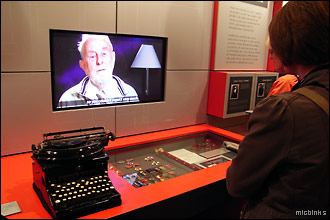
We followed through the bunker's narrow underground corridors before
moving into the Churchill Museum, opened in 2005 by...
|
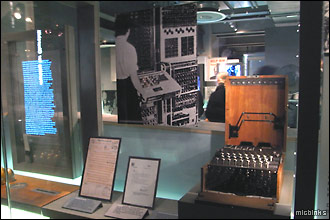
...the Queen. In this shot there's a captured German Enigma
cipher machine and behind, we think, a picture of the Colossus wartime
computer.
|
|
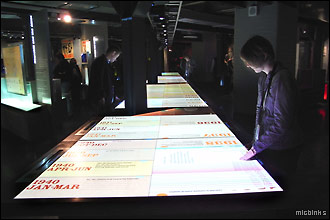
Deep inside the Churchill Museum we tried this awesome interactive
timeline - the Churchill Lifeline cataloguing key world events during
his time. By tapping on the year the months opened up to reveal
events in documents, photos and film.
|
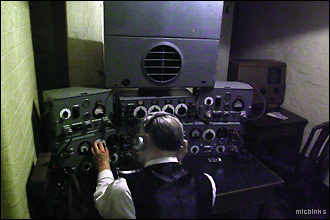
Winston Churchill's wartime morale boosting radio broadcasts to the
nation were legendary and the BBC had the necessary facilities
installed here in the War Rooms. 'we shall fight them on the
beaches... ...we shall never surrender!'
|
|
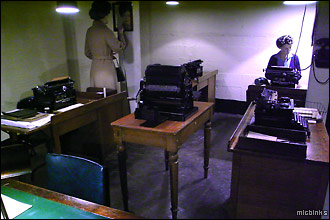
Key government and military staff lived and worked underground in the
bunker, some didn't see daylight for weeks on end. Although a
reinforced three-metre concrete slab was fitted above the rooms, a
direct hit from a large bomb of 300 kg + would have wiped out the
Cabinet War Rooms.
|
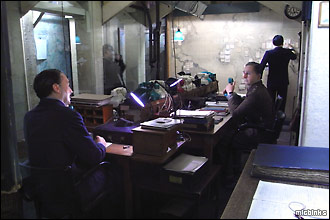
The Map Room was the bunker's information centre. On view were
the colour-coded telephones called the ‘beauty chorus’, wall mounted
wartime maps and the Convoy Map seen at the far end. Amazingly,
the Map Room has been left exactly as it was at the end of WWII -
haven't the staff aged well!
|
|
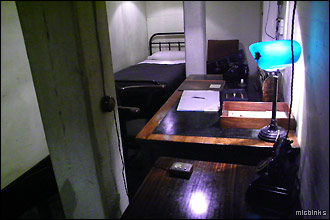
During the course of World War Two, important cabinet members had
sleeping quarters in the underground War Rooms; these were rather basic
and cramped except for...
|
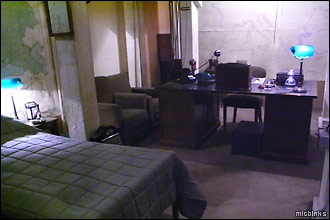
...Churchill’s Room which was more spacious, carpeted and had a more
comfy looking bed, although he only slept in it three times!
However, he made some of his wartime speeches from his desk here.
|
|
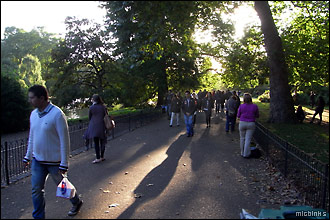
London is a very popular tourist destination of course, even late
season, as you can see here in St. James's Park still thronged with
people late in the day as we made our way to the Bomber Command
Memorial.
|
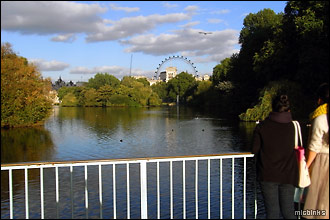
We paused a while on the bridge over St. James's Park Lake, admired the
early autumn colours and spotted the London Eye, a previous London
visit for us back in 2002.
|
|
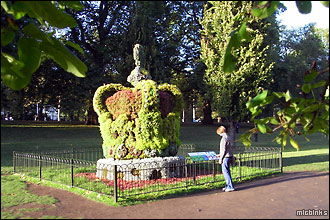
London's parks are fabulous (see our Hyde
Park visit) and just to remind us of that we came across this royal
crown in St. James's Park made out of hedge.
|
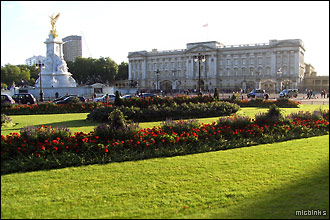
Presently we crossed The Mall into Green Park and stopped to take this
shot of Buckingham Palace and Victoria Memorial.
|
|
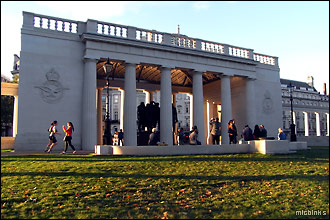
At the Hyde Park Corner end of Green Park the Bomber Command Memorial
is housed in this pavilion. Unveiled in June 2012, the memorial
cost...
|
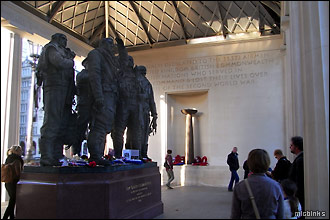
...some £6m and forms a worthy tribute to the 55,573 - half the
total who flew - Bomber Command airmen who perished on bombing
missions. The odds...
|
|
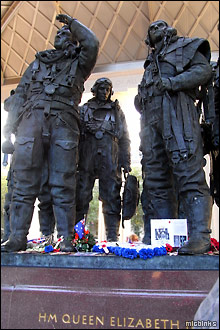
...sure were stacked against those brave guys. The bronze
memorial statues depict a bomber crew.
|
Bomber Command and the memorial have both attracted
controversy and disagreement, what with the carpet bombing of German
targets - instigated by Sir Arthur 'Bomber' Harris - during World War
Two and the somewhat imposing memorial attracting criticism from some
quarters. What's clear though is that at last the bomber boys
have been recognised for the huge sacrifice they made to defend Britain
during WWII - and that can't be argued with.
We used supermarket reward vouchers to cover the entry
cost for both Britain at War and Churchill War Rooms, otherwise the
costs at the time of our visits for adult entry would have been £14.50
and £16.50 respectively.
Churchill War Rooms is part of the Imperial War Museum
(IWM) so watch out for their 'voluntary' donation that is sneakily
added in to the entry price, as we discovered the previous year when we
toured Duxford military
aviation museum.
|
